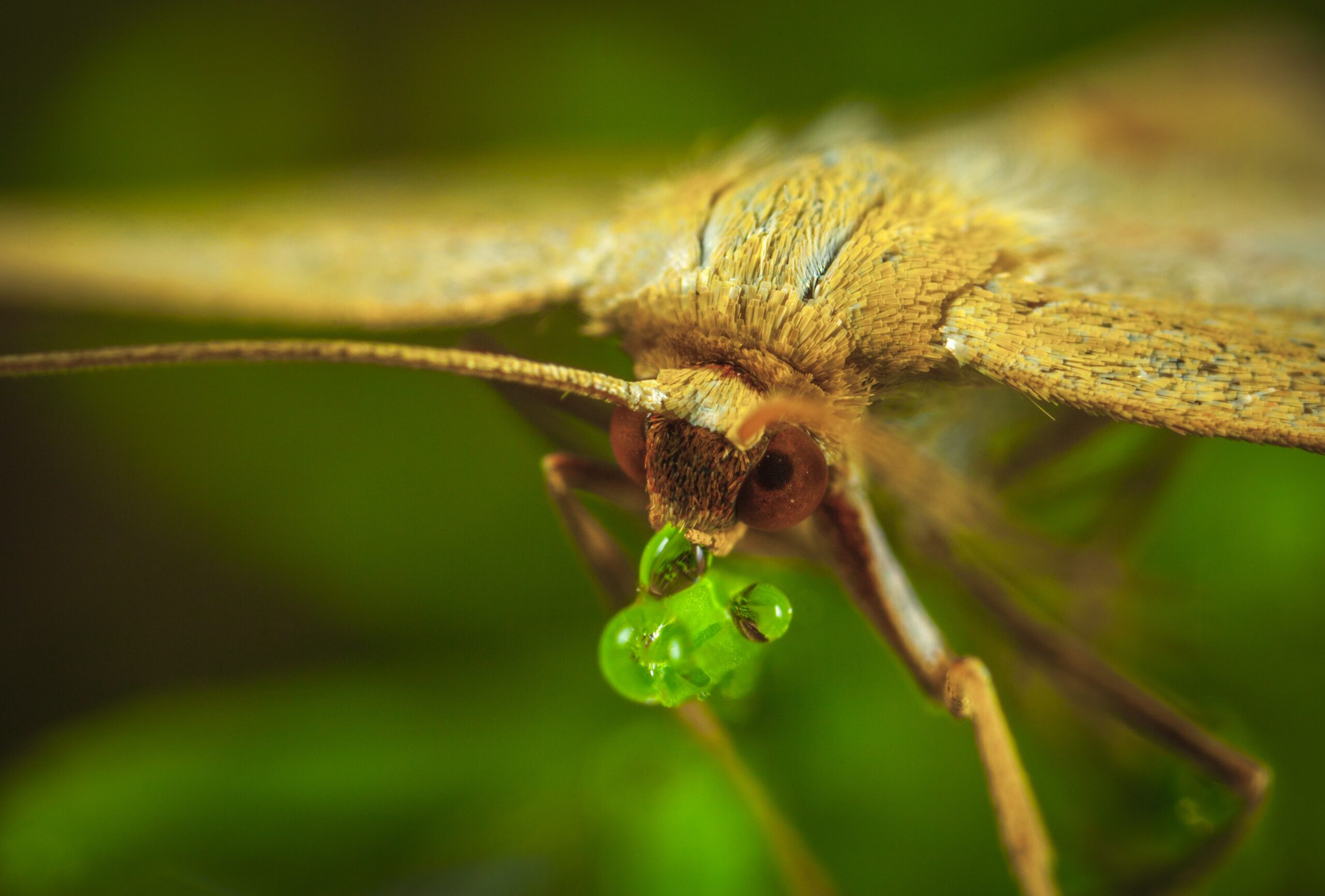A most destructive vegetable pest in South Africa is the tomato leaf miner. Although this pest is more commonly known as Tuta, the species has recently been moved to the same genus as the potato tuber moth, i.e. Phthorimaea (we retain the genus Tuta and common name Tuta here to prevent confusion).
Both these pests are leaf mining caterpillars of two very similar micro-moths, and are often mistaken for each other, both in the damage they cause as well as in identifications of the moths and caterpillars. In this article we highlight the most common differences between the two species, to aid farmers in identifications and therefore correct implementation of control strategies.
Moths
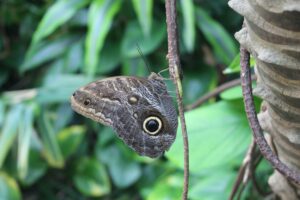
The moths of both species are small (<10 mm), and difficult to see in crop fields under normal pest pressure. They hide during daytime and are only encountered when the foliage of plants is disturbed. However, Tuta is known to occur in such huge numbers that “clouds of mingling moths” may sometimes be noticed in fields, even during daytime. For the untrained eye the difference between the moths of these two species is only evident in their size; tuber moth is slightly larger than the moths of Tuta (approximately 8 mm vs 6 mm).
Caterpillars
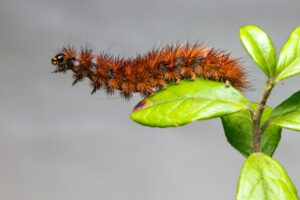
The caterpillars (larvae) of both species are leaf miners. They are seldom found outside their blotch-like leaf mines and therefore are seldom seen. Leaf mines must be dissected or “broken open” to inspect the caterpillars for identifications. Most of the leaf mines will be empty, however, except under high pest pressure.
The larvae of the tuber moth are greenish brown to pinkish and about 10 mm in length. Tuta larvae are more greenish and approximately 8 mm in length. A diagnostic feature of the larvae is the thin black line on the prothoracic shield (dorsally behind the head) of Tuta, while the tuber moth larva has a broader dark brown to black shield.
Host plants
Both species attack plants in the Solanaceae family, e.g. potato and tomato. However, the potato tuber moth prefers potato, while Tuta prefers tomato. A mixture of both these species will always be found in potato and tomato fields. In tomato fields Tuta will always be the more abundant and damaging species. The occurrence of the two species in potato fields is, however, more complicated. Under certain conditions, which are still unclear, Tuta numbers may be much higher than that of the tuber moth.
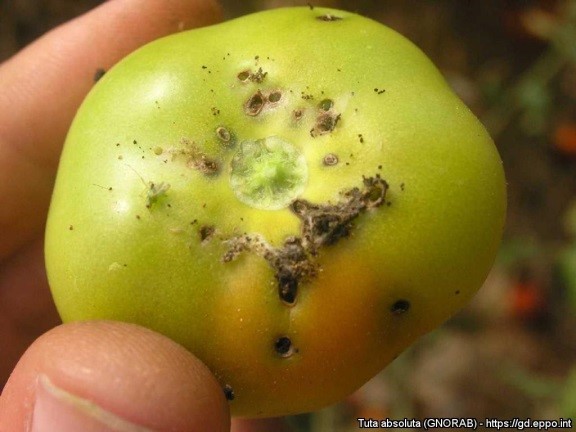
Tuta absoluta, the tomato leafminer moth, has become an increasingly important pest in South Africa since 2016, undermining tomato production. Farmers have suffered serious yield losses, and increased expenditure in their attempts to control the pest.
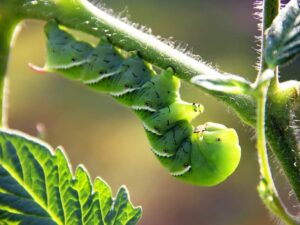
This insect can reproduce at an alarming rate during warm to hot conditions (15 days per cycle at 35°C). Since the larvae tunnel into a tomato plant’s leaves as soon as they emerge from their protective egg cases, they easily escape contact insecticide applications. A completely integrated pest management (IPM) programme is the only effective means offering sustainable control of Tuta absoluta.
Several principles have to be strictly followed in an IPM programme:
Sanitation is extremely important and involves the removal of leaves when the first signs of feeding damage are noticed. This should only be practised up to a point. Plants must not be debilitated by excess loss of leaf area or so that fruit suffers sunscald.
At the end of the season, plants and all plant material must be removed as soon as possible and buried to prevent new moths emerging from pupae in or on the plant material. A host-free period of about six weeks will further reduce the number of moths when the season starts.
Weed control of especially solanaceous weeds (thorn apple, nightshade, bitter apple) and crop rotation out of the potato family (potato, tobacco, pepper, eggplant, tomato, gooseberries) should help break the pest cycle.
Early detection using pheromone delta traps, mass traps (~40 per ha installed 80 cm above ground, even before transplant) and black or yellow sticky traps can give an early indication of increases in pest populations. Traps can also reduce the population of male moths. Insect-attracting ultraviolet light systems used at night in closed greenhouses can further reduce the moth populations.
Biological control might not be the fastest-acting control measure, but it is one of the most sustainable. These eco-friendly products range from bacteria (e.g. Bacillus thuringiensis, Paenibacillus chitinolyticus), fungi (e.g. Beauveria bassiana, Metarhizium spp.) and granuloviruses that will infect the moths and larvae, to parasitic insects and nematodes that will feed on the pest and reduce populations.
Chemical control is probably the most favoured measure of most farmers, but care must be taken to prevent pests from developing resistance to the products, something for which Tuta absoluta is renowned. Spray application can be improved by pruning plants to two leaders and allowing better cover on the developing fruit.
Principles to follow in chemical control of Tuta absoluta include:
An anti-resistance management programme allowing block sprays of two applications of a chemical from a specific mode of action (MoA – referring to specific IRAC codes); alternation should allow for at least 60 days between chemicals from the same MoA
Always check the label of the chemical to determine its optimal pH, and adjust the spray mix accordingly (spray water quality is very important). Use only registered chemicals and adhere to the relevant label dosages; this prevents under- or overdosing of a chemical.
Utilise improved stickers or wetting agents to improve application efficacy:
Eco-friendly chemicals that don’t kill beneficial insects should be preferred to the older, harsher alternatives. An environmentally friendly approach to farming will lead to wider biodiversity and the proliferation of the natural enemies of Tuta absoluta, including insect-eating birds and bats.
The damage potential of this species lies in its ability to reproduce at a very high rate, and occurring in much higher numbers compared to the potato tuber moth. In potato fields, however, their high reproduction rate is mostly suppressed in comparison to their occurrence on tomatoes. This may be due to host preferences. However, under certain conditions, which still are not completely understood, Tuta may occur in potato fields in such high numbers that the mining larvae may cause foliage dieback.
However, because the lure formulations are species specific, and because the effectiveness of the formulations may differ between the two species, counts and analyses must be interpreted carefully when tuber moth and Tuta pheromone catches are compared. In general, we have found that the Tuta pheromone lures are much more potent, and that more Tuta moths are caught in traps compared to tuber moths in the same fields. By: Dr Diedrich Visser of the ARC’s Insect pests research centre

